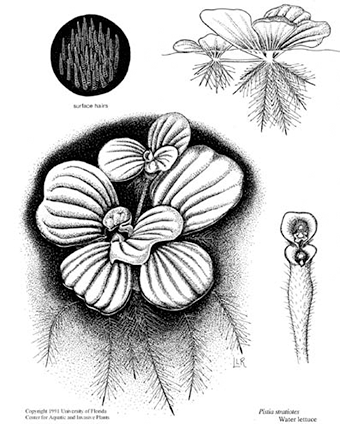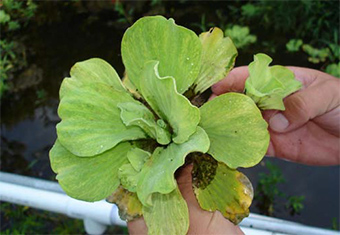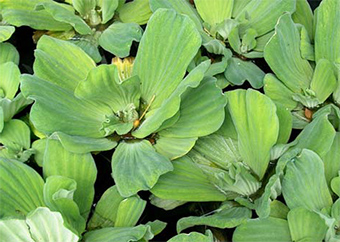Water lettuce
What you need to know about water lettuce. Includes habitat, identifying features and what you can do to reduce its impact.
Water Lettuce (Pistia stratiotes)
Water lettuce is a free-floating aquatic plant whose origins are uncertain. An explorer in 18th century Florida was the first person to record its presence in North America. Some experts believe it is native to the southeastern United States, while others believe it came from Africa, southern Asia or South America.

It was likely moved beyond its native range by ships carrying it in their ballast and by people using it in water gardens, aquariums and ponds. Water lettuce is a prohibited plant in Florida, Louisiana, Mississippi and Texas, and is considered a noxious weed in South Carolina and Delaware.
Water lettuce forms large, dense floating mats. The plant can adapt to life in ponds, lakes and quiet areas of rivers and streams, but cannot withstand salt water. While not usually able to tolerate cold temperatures, several populations of water lettuce have been observed in Ontario, and they may be successfully reproducing. Scientists are currently studying where water lettuce is growing in Ontario, whether it is able to survive Ontario's winters, and whether it is likely to spread.
Range
While biologists have different opinions about the origins of water lettuce, its native range is tropical or subtropical. In warm climates it is a perennial, but in temperate regions like southern Ontario it may survive as an annual. In Ontario it has been found in ponds connected to the Rideau Canal near Ottawa, and in the Welland Canal in the Niagara Region, Lake St. Clair and its tributaries, Bronte Creek in Oakville, and beaches east of Toronto.
Impacts of water lettuce
- The plant forms thick mats that block sunlight and slow or prevent the growth of native aquatic plants.
- As the plant dies and decomposes, it removes oxygen from the water, which can disrupt fish communities.
- Dense mats of water lettuce can hinder swimmers and boaters, prevent other recreational uses of waterways, and restrict water flow in irrigation and flood control canals.

How to identify water lettuce
- The free-floating plant forms a rosette or group of leaves arranged in a circle that resembles an open head of lettuce. Thick, ridged leaves are two to 20 centimetres long and light green, with short, white hairs, rounded ends and no stems.
- Flowers are small and white to pale green.
- The plant produces a green berry that turns brown at maturity.
- Many feathery roots 50 to 80 centimetres long hang under the rosette of leaves.
- Large numbers of plants may be connected by underwater runners called stolons.

Photo: Graves Lovell, Alabama Department of Conservation and Natural Resources, Center for Invasive Species & Ecosystem Health (University of Georgia)
What you can do
- Learn how to identify water lettuce and how to prevent accidentally spreading this plant with your watercraft.
- Avoid infested areas or reduce your speed when boating near water lettuce infestations.
- Inspect your boat, trailer and equipment after each use.
- Remove all plants, animals and mud before moving to a new waterbody.
- Avoid planting water lettuce in your aquarium or water garden. Aquarium hobbyists and water gardeners should only use native or non-invasive plants. Ask your retailer about plants that are not invasive.
- Never release unwanted aquarium plants or pets. Return or donate unwanted plants to a garden centre or pet store, or put them in the garbage.
- If you've seen water lettuce or another invasive species in the wild, please contact the toll-free Invading Species Hotline at
1-800-563-7711 , or visit Ontario's Invading Species Awareness Program to report a sighting.
Other resources
- Invasive species centre
- Ontario invasive plants council
- Invasive species
- Ontario's Invading Species Awareness Program
For more information:
Please contact the Invading Species Hotline at

Photo: Heather Smith, OFAH
This fact sheet may be reproduced for non-commercial purposes. © 2012
Cette publication est également disponible en français.